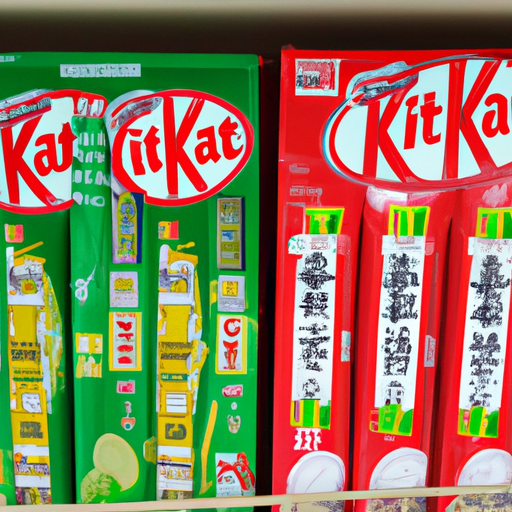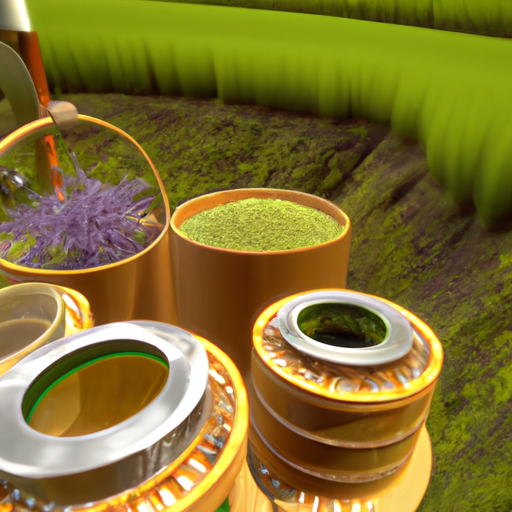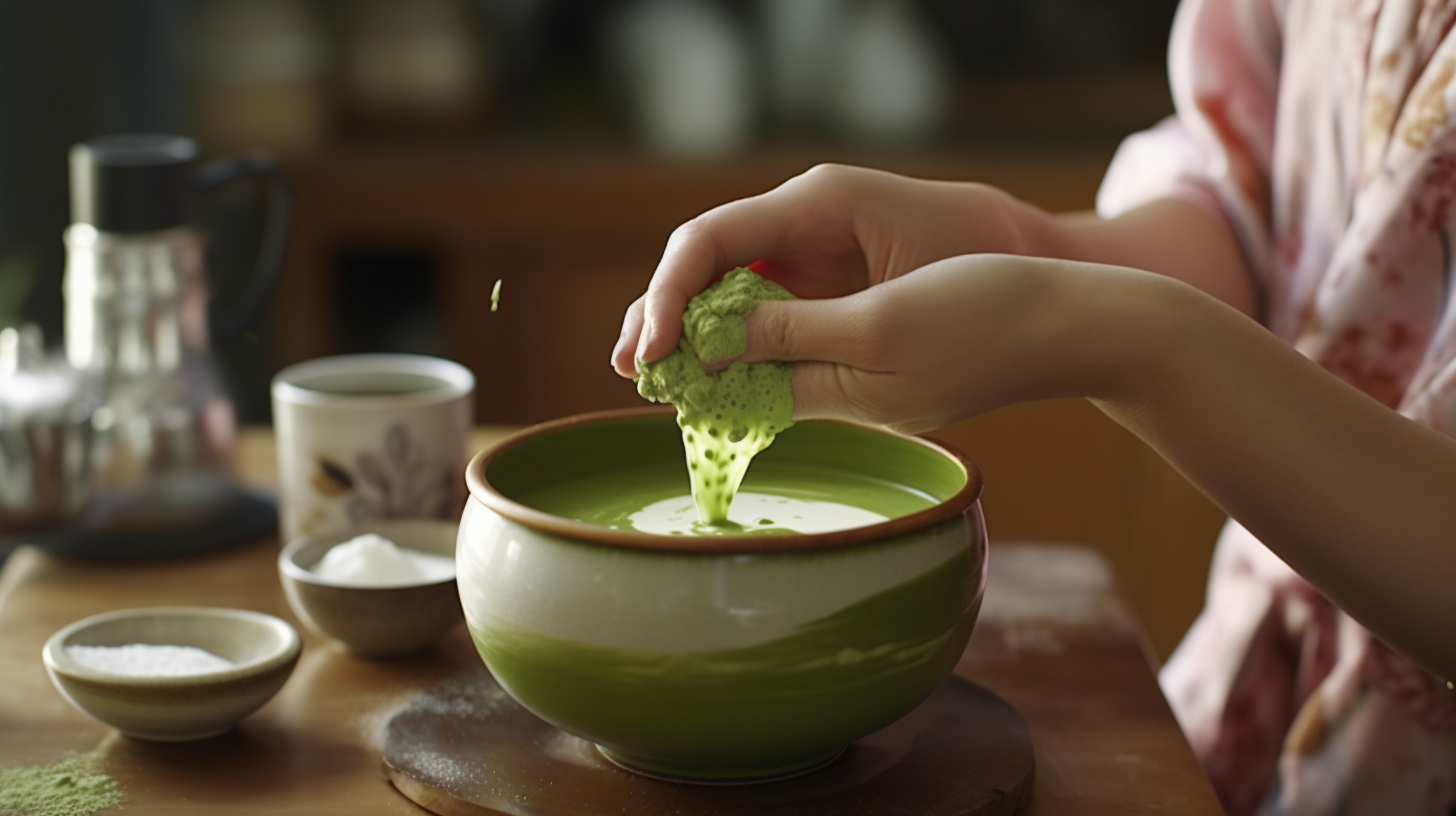I’m totally into matcha frappes and have been whipping them up at home for some time. They’re an ideal cool beverage for sweltering summer days, plus they offer an energy lift alongside all the nutritional advantages of matcha powder. Should you wish to craft your very own matcha frappe, I’ve prepared a detailed tutorial for you.
To start off, you’ll need to gather all the necessary ingredients and tools. This includes high-quality matcha powder, milk (or alternative milk), sweetener of your choice (such as honey or agave syrup), ice cubes, a blender, and a measuring spoon/cup.
Once you have everything ready, it’s time to get started on preparing the matcha powder and other ingredients before mixing them together to create the perfect frothy frappe.
Key Takeaways
- Use high-quality ceremonial grade matcha powder for the best taste and health benefits
- Experiment with natural sweeteners like honey and maple syrup, and adjust taste and thickness by adding more milk or matcha powder
- Properly blend the ingredients with a high-speed blender and sift the matcha powder for a smooth and rich flavor
- Incorporating matcha into your daily routine can provide many health benefits, including an energy boost and antioxidants.
Necessary Ingredients
You’ll need just a few ingredients to make this delicious matcha frappe. The first and most important ingredient is, of course, matcha powder. You can find this at any health food store or online retailer that specializes in Japanese tea products. Be sure to choose a high-quality matcha powder for the best taste and health benefits.
Other necessary ingredients include milk, sweetener, ice cubes, and whipped cream (optional). For the milk, you can use any kind you prefer – dairy or non-dairy. Sweeteners such as honey or agave syrup work well with matcha’s slightly bitter flavor profile. If you’re looking for variations on Matcha Frappe, experiment with different sweeteners like maple syrup or coconut sugar.
Matcha powder packs a powerful punch of antioxidants and other nutrients that have been shown to improve brain function and reduce the risk of chronic diseases. Incorporating it into your diet is an easy way to reap these benefits while enjoying a tasty treat at the same time. Keep these health benefits in mind as you prepare your matcha frappe!
Now that we’ve gone over the necessary ingredients for making a delicious matcha frappe, let’s move on to the tools required…
Tools Required
Tools required:
To prepare this delicious matcha frappe, all that’s needed are a few essential tools. Here are the five tools required to make your own homemade matcha frappe:
- Blender: A high-speed blender is recommended for smooth and creamy texture.
- Measuring cups/spoons: You’ll need precise measurements of ingredients to create the perfect balance of flavors.
- Strainer: A fine mesh strainer is necessary to sift the matcha powder and remove any lumps.
- Ice cube tray: Freeze some milk or cream in an ice cube tray beforehand to add extra creaminess without diluting the flavor.
- Tall glass: Serve your matcha frappe in a tall glass for maximum enjoyment.
When using a blender, it’s important to adjust the settings according to your desired consistency. Start at low speed and gradually increase until you reach a smooth texture with no visible lumps. It usually takes around 30 seconds to blend everything together properly.
Once you have all your tools ready, it’s time to move on to preparing the matcha powder.
Preparation of Matcha Powder
As you delve into the world of matcha frappes, the first step is to sift your matcha powder like a miner panning for gold, ensuring that any clumps are removed for a smooth and rich flavor. This step is crucial as it ensures that you get an even distribution of the powder in your drink. Sifting also helps prevent lumps from forming, which can affect the texture and taste of your matcha frappe.
When preparing your matcha powder, it’s important to use ceremonial grade matcha. This high-quality tea has numerous health benefits such as boosting metabolism, enhancing mood and concentration levels, and providing antioxidants. Ceremonial grade matcha is made from young leaves that are carefully handpicked, steamed, dried, and stone-ground into fine powder. The result is a vibrant green color with a sweet aroma and delicate flavor.
Incorporating ceremonial grade matcha into your daily routine provides many health benefits while giving you a refreshing boost of energy in every sip of your matcha frappe. Now that we have our sifted powdered tea ready let’s move on to preparing other ingredients for our delicious drink!
Preparation of Other Ingredients
Now that I’ve prepared the matcha powder for my frappe, it’s time to move on to other ingredients.
First, I need to measure out the milk accurately to ensure the right balance of creaminess and sweetness in my drink.
Next, choosing a sweetener is crucial as it can make or break the taste.
Finally, preparing ice cubes may seem like a simple task, but it’s important to use filtered water and allow them enough time to freeze completely before using them in your drink.
How to measure milk
First, you’ll want to grab a measuring cup and pour in the desired amount of milk, making sure not to overfill it. Measuring milk may seem like a simple task, but there are tips and tricks that can make all the difference.
One common mistake is using a dry measuring cup instead of a liquid one. Dry cups are meant for solid ingredients and won’t give an accurate measurement for liquids like milk. Another tip is to make sure your measuring cup is on a flat surface when pouring in the milk. This ensures that the amount you’re measuring is accurate.
Additionally, be sure to read the measurement at eye level rather than from above or below. These small adjustments can result in a perfectly measured amount of milk for your matcha frappe.
Now that we have our milk sorted out, let’s move on to choosing the perfect sweetener for our frappe without overpowering its delicate flavor profile.
How to choose a sweetener
Choosing the perfect sweetener for your matcha frappe can be a tricky task, but with a little creativity and some flavor experimentation, you’ll find the ideal complement to its unique taste.
There are many types of sweeteners available in the market today, including natural and artificial ones. Natural sweeteners like honey and maple syrup have their own distinct flavors that can add depth to your matcha frappe. However, they tend to be more expensive compared to artificial sweeteners.
On the other hand, artificial sweeteners like sucralose and aspartame are low-calorie options that can provide the same level of sweetness without adding extra calories. The downside is that they may leave an aftertaste or have potential health risks when consumed in large quantities.
Ultimately, choosing between natural vs artificial sweeteners will depend on personal preference and dietary needs.
Now let’s move on to how to prepare ice cubes for your matcha frappe!
How to prepare ice cubes
Get ready to elevate your matcha frappe experience by preparing ice cubes that’ll keep your drink cool and refreshing without diluting its flavor!
One way to do this is by using alternative ice cube trays, such as silicone molds or large-sized ice cube trays. These options allow you to create unique and creative shapes for your ice cubes, adding a fun touch to your matcha frappe.
Another option is to infuse the water in the tray with additional flavors, such as lemon or mint. This adds a subtle twist to your matcha frappe while still keeping it cool.
Whichever method you choose, make sure to freeze the tray overnight before serving.
Now that we have our perfect ice cubes ready, let’s move on to the mixing of ingredients for our delicious matcha frappe!
Mixing of Ingredients
To mix the ingredients for my matcha frappe, I start by adding the ice cubes to my blender.
Next, I pour in the prepared matcha mixture and add a generous scoop of vanilla ice cream.
Finally, I blend everything together on high speed until it reaches a creamy and frothy texture.
Achieving this texture is key to a delicious matcha frappe that’s perfect for any time of day!
How to blend the ingredients
Once all the ingredients are in the blender, it’s like a DJ mixing beats – you want to start slow and gradually increase the speed until everything is blended together smoothly. Blending techniques are important for achieving a smooth consistency, especially when working with ice and matcha powder.
Here are some tips to help you achieve a perfect blend:
-
Start on low speed: Begin by pulsing your blender on low speed until everything is combined.
-
Increase the speed: Once everything is mixed well, gradually increase the blender speed to high.
-
Blend for 30 seconds: Let the mixture blend for at least 30 seconds or until it reaches a smooth consistency.
-
Check for lumps: If there are still lumps or clumps of matcha powder or ice, stop blending and stir with a spoon before continuing.
By following these blending techniques and troubleshooting tips, you can ensure that your matcha frappe has a smooth consistency without any lumps or clumps.
In order to achieve a creamy and frothy texture, we’ll need to move onto our next step – adding air into the mixture through whisking!
How to achieve a creamy and frothy texture
Now it’s time to take your matcha frappe to the next level and create a creamy, frothy texture that will make your taste buds dance with joy. To achieve this, start by adding alternative sweeteners such as honey, agave syrup, or stevia to the blender along with your other ingredients. These sweeteners not only add natural sweetness but also help in creating a smooth texture.
Next, use different frothing techniques like shaking, whisking, or blending on high speed for several minutes until you get a thick and creamy consistency. This step is crucial as it creates tiny air bubbles within the mixture, resulting in a frothy texture.
Once done, pour the mixture into a glass and enjoy the velvety goodness of your homemade matcha frappe. To adjust the taste of your matcha frappe even further, there are some additional steps you can take.
Adjusting the Taste
Now that I’ve mixed all the ingredients together, it’s time to adjust the taste of my matcha frappe.
First, I’ll need to determine if it needs to be sweeter or less sweet. If it’s too sweet, I can add a little bit more milk or matcha powder. On the other hand, if it’s not sweet enough, I can add more sugar or honey.
Additionally, if the frappe is too thick for my liking, I can add more ice or milk to thin it out until it reaches my desired consistency.
How to adjust the sweetness
Adjusting the sweetness of your matcha frappe is like finding the perfect balance between sweet and earthy flavors. Here are some ways to do it:
-
Sugar vs Honey: If you prefer a sweeter taste, add sugar; if you want a healthier option, use honey. Keep in mind that honey has a stronger flavor and may overpower the matcha’s subtle taste.
-
Using Flavored Syrups: Flavored syrups like vanilla or caramel can complement the matcha’s natural flavor while adding sweetness to your drink.
-
Taste Testing: While making your matcha frappe, take small sips along the way to gauge its sweetness level. Once you find it too sweet or not sweet enough, adjust accordingly.
-
Adding Milk: Sometimes milk can make your drink sweeter without having to add extra sugar or honey. Consider adding milk during blending if you think your drink needs more sweetness.
Now that we’ve adjusted our matcha frappe’s sweetness level, let’s move on to adjusting its thickness by altering the amount of ice used in the recipe.
How to adjust the thickness
To achieve a thicker consistency in your matcha frappe, simply add more ice to the blender. As you blend the ingredients together, gradually add ice cubes until you reach your desired thickness. It’s important to keep in mind that adding too much ice can dilute the flavor, so be sure to adjust accordingly.
Another way to adjust consistency is by using different types of milk or milk alternatives. For example, if you prefer a creamier texture, try using whole milk or coconut milk instead of almond milk. Additionally, experimenting with different sweeteners and flavor variations can also affect the thickness of your drink. Using honey instead of sugar may result in a thicker consistency due to its viscosity. Overall, adjusting the consistency is all about finding what works best for you and your taste preferences.
Now that we’ve covered how to adjust the thickness of our matcha frappe, let’s move on to serving it up!
Serving the Matcha Frappe
When presenting your matcha frappe, be the artist and carefully place a dollop of whipped cream on top like a delicate brush stroke on a canvas. This presentation tip adds an elegant touch to your drink, making it look more visually appealing.
You can also sprinkle some matcha powder or chocolate shavings on top for additional texture and flavor. Garnishing ideas are endless when it comes to matcha frappes.
You can add a slice of fruit like a strawberry or kiwi as a side garnish or use edible flowers like lavender or rose petals. Another option is to drizzle caramel sauce or honey around the rim of the glass for added sweetness and decoration.
Serving your matcha frappe with attention to detail not only elevates its appearance but also makes it taste better by enhancing the overall experience. As you enjoy your beautifully presented drink, keep in mind these tips for making perfect matcha frappes.
Tips for Making Perfect Matcha Frappe
When it comes to making the perfect matcha frappe, I’ve found that using high-quality ingredients is key. Experimenting with different flavors can also help elevate your drink game. However, it’s important to avoid common mistakes like over-mixing or not properly measuring your ingredients.
By following these tips and taking a little extra care, you’ll be sipping on a delicious and perfectly crafted matcha frappe in no time.
Using high-quality ingredients
For the ultimate matcha frappe experience, you’ll want to splurge on high-quality ingredients. Matcha is a finely ground powder made from specially grown green tea leaves, and it has many benefits for your health.
When choosing matcha for your frappe, look for ceremonial grade or premium grade varieties that are sourced directly from Japan. There are several sources of high-quality matcha, including specialty tea shops and online retailers. Be sure to read reviews and check the freshness date before making a purchase.
Using high-quality matcha will not only enhance the flavor of your frappe but also ensure that you’re getting all the health benefits of this superfood ingredient. Now that you have the perfect matcha base, let’s move on to experimenting with different flavors.
Experimenting with different flavors
Who would’ve thought that adding unexpected flavors like lavender or ginger to your matcha frappe could actually make it taste even better? Flavor combinations are key to creating a unique and delicious matcha frappe. Don’t be afraid to experiment with different ingredients, such as honey, vanilla extract, or even coconut milk.
To get started with flavor testing, begin by selecting one ingredient at a time. For example, try adding a small amount of lavender syrup to your matcha frappe before blending. Taste test until you find the right balance between the two flavors. If you’re feeling adventurous, mix and match different ingredients until you discover your perfect combination.
Remember that not all flavor pairings will work well together; some may clash and create an unpleasant taste. Be sure to take notes on each combination so that you can recreate the ones that are successful in the future.
As we move into avoiding common mistakes when making matcha frappes, keep in mind that experimenting with different flavors is important but can also lead to errors if not done correctly.
Avoiding common mistakes
To ensure a smooth and delicious matcha frappe experience, you’ll want to avoid some common mistakes. One of the most common mistakes is not properly blending the ingredients. It’s important to blend the matcha powder with a small amount of hot water first before adding it to the blender with ice and other ingredients. This ensures that the matcha powder is fully dissolved and evenly distributed throughout the drink.
Another mistake to avoid is using too much sweetener. Matcha has a naturally sweet taste, so adding too much sugar or syrup can overpower its delicate flavor. It’s best to start with just a small amount of sweetener and adjust according to your taste preferences.
Additionally, make sure to use quality ingredients, such as fresh milk or alternative milks, for optimal taste and texture. By following these tips for success, you can enjoy a perfectly balanced matcha frappe every time!
Frequently Asked Questions
How long does it take to make a matcha frappe?
When it comes to making a matcha frappe, preparation time is key. The amount of time it takes to make a matcha frappe can vary depending on the recipe and equipment used. Generally speaking, it can take anywhere from 5-10 minutes to prepare and blend the ingredients together until you achieve the desired consistency.
However, the best time to enjoy a matcha frappe is during hot summer months when you want something refreshing and energizing. So, if you’re looking for a quick and easy way to cool down this season, try making your own matcha frappe at home!
Can I use a different type of milk instead of dairy milk?
When it comes to making a matcha frappe, you can definitely use non-dairy milk alternatives. There are plenty of options such as almond, soy, and coconut milk that will provide a similar creamy texture to dairy milk. It ultimately comes down to personal taste preferences.
If you prefer a nuttier flavor, almond milk may be the way to go. On the other hand, if you want something with a bit more sweetness, coconut milk could be the better choice. Whatever alternative you choose, just make sure it’s unsweetened so that it doesn’t overpower the delicate matcha flavor.
Can I substitute sugar with a healthier alternative?
When it comes to making healthy Matcha Frappe recipe variations, it’s important to pay attention to the sweeteners you use. While sugar is a common ingredient in frappes, there are many healthier alternatives available.
Some of my favorite healthy sweeteners include honey, maple syrup, and stevia. Honey is a natural sweetener that also has anti-inflammatory properties. Maple syrup provides a rich flavor and contains antioxidants and minerals like zinc and manganese. Stevia is a zero-calorie option that won’t spike your blood sugar levels like traditional sugar does.
Experiment with these healthy sweeteners in your Matcha Frappe recipe variations for a guilt-free treat!
Can I make a matcha frappe without a blender?
When it comes to making a matcha frappe without a blender, there are two methods: hand whisking or using matcha frappe powder. Hand whisking requires you to pour your ingredients into a jar or cup and vigorously shake until frothy. This method is time-consuming and may not yield the same smooth texture as using a blender.
On the other hand, matcha frappe powder is designed specifically for creating a creamy, blended beverage without the need for additional equipment. It typically contains sugar and other ingredients to create a sweet and flavorful drink.
If you only have regular matcha powder on hand, it can still be used to make a frappe by adding sweetener and blending with ice and milk in a high-powered blender. However, the texture may not be as smooth as when using matcha frappe powder specifically designed for this purpose.
How many calories are in a matcha frappe?
I know that many people are concerned about the calorie count in matcha frappes, but rest assured that this drink can actually be a healthy option when made with the right ingredients.
Matcha is packed with antioxidants and has been shown to boost metabolism and improve brain function. There are different types of matcha powder available, such as ceremonial grade and culinary grade, which may differ in taste and nutritional content.
When making a matcha frappe, it’s important to use unsweetened almond milk or coconut milk instead of dairy milk, as well as natural sweeteners like honey or maple syrup. By using these healthier alternatives, you can enjoy a delicious matcha frappe without worrying about excess calories or added sugars.
Conclusion
In conclusion, making a perfect matcha frappe requires attention to detail and careful execution. It’s an easy beverage to prepare if you have the necessary ingredients and tools.
The key is to balance the sweetness of the milk and sugar with the earthy bitterness of matcha powder. As they say, "practice makes perfect."Don’t be discouraged if your first attempt doesn’t turn out exactly as you expected. Keep experimenting with different ratios of ingredients until you find what works best for your taste buds. Remember, always use high-quality matcha powder for the best results.
In addition, make sure that your blender or shaker can handle ice cubes without breaking down or overheating. And most importantly, don’t forget to enjoy the process! Making a matcha frappe can be a fun and creative way to add some variety to your daily routine while reaping all of its health benefits.
So, go ahead and give it a try!










